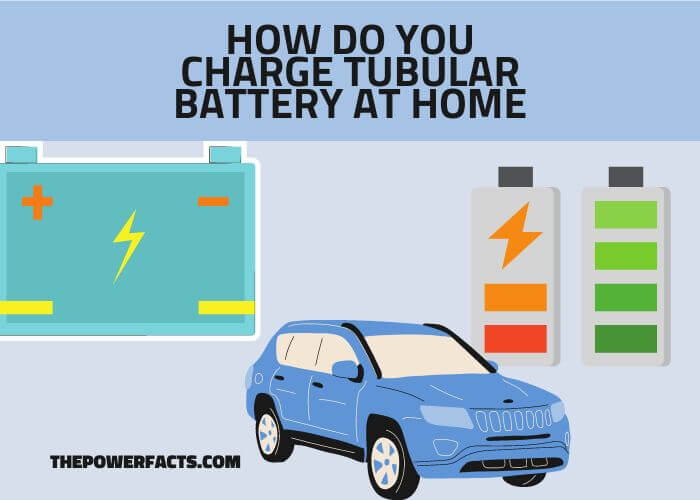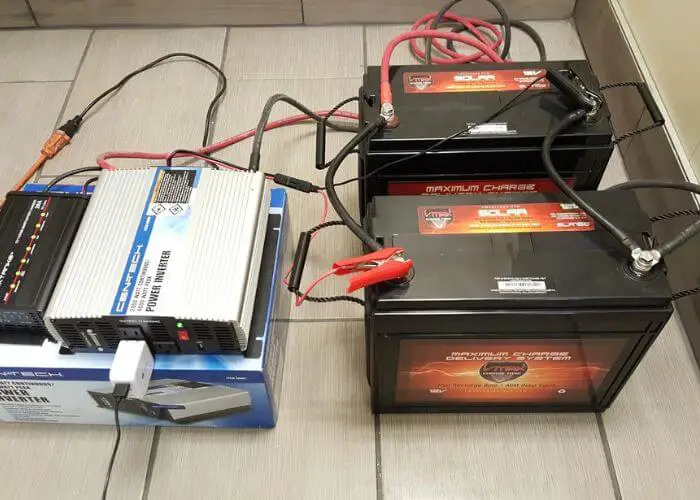Tubular batteries are one of the most common lead-acid batteries used in homes. They are known for their high capacity and long life, but they can be tricky to charge. Here are a few tips on charging your tubular battery at home.

To charge a tubular battery at home, you will need a few things. First, you will need a charger specifically designed for tubular batteries. You can find these online or at most hardware stores.
Second, you will need to connect the positive and negative terminals of the battery to the corresponding terminals on the charger. Finally, you will need to plug the charger into an outlet and wait for the charging process to complete.
Can We Charge the Inverter Battery at Home?
Yes, you can charge an inverter battery at home. Inverter batteries are lead-acid batteries that can be charged with a standard car battery charger. However, it’s essential to read the instructions with your inverter battery before charging it, as some batteries may require special chargers or settings.
How Do You Take Care of a Tubular Battery?
A tubular battery is a type of lead-acid battery that uses positive tubular plates. The main advantages of tubular batteries over other types of lead-acid batteries are higher capacity, longer life, and lower maintenance requirements. To get the most out of your tubular battery, it’s important to maintain it properly.
Here are some tips for taking care of your tubular battery:
| Tip one | Keep the battery clean and dry. Dirt and grime can cause the battery terminals to corrode and reduce the overall system’s efficiency. |
| Tip two | Inspect the electrolyte level regularly and top up with distilled water as needed. |
| Tip three | Avoid overcharging or deep discharging the battery, as this will shorten its lifespan significantly. |
| Tip four | Avoid overcharging or deep discharging the battery, as this will shorten its lifespan significantly. |
| Tip five | Periodically check for loose connections and tighten them if necessary. |
What is the Charging Voltage for Tubular Battery?
Tubular batteries are lead-acid batteries that have a series of tubes instead of the usual flat plates. The charging voltage for these batteries is usually between 2.2 and 2.4 volts per cell or about 13.2 to 14.4 volts for a 12-volt battery. Higher voltages may be used for faster charging but can shorten the battery’s life if used too often.
How Can I Charge My Generator Battery at Home?

Assuming you have a generator with a 12-volt battery, there are a few things you can do to charge it at home:
| Step one | First, ensure the generator is turned off and disconnected from any power sources. Next, locate the positive and negative terminals on the battery. |
| Step two | You need to connect the battery to a charger that delivers at least 10 amps to charge it. |
| Step three | Once connected, turn on the charger and let it run until the battery is fully charged. This could take several hours, so be patient. |
| Step four | Finally, disconnect the charger and reattach any cables or wires removed during charging. |
Charging the Battery While Connected to the Inverter
When it comes to charging your batteries, there are a few things you need to consider:
- One of those things is whether or not you should charge your battery while connected to an inverter. The answer to this question depends on the type of inverter you have.
- If you have a modified sine wave inverter, it is wonderful to charge your battery while it is connected to the inverter.
So, what’s the difference between a modified sine wave and a pure sine wave?
A modified sine wave has stepped in its output, whereas a pure sine wave does not. This means that a modified sine wave will produce less power than a pure sine wave and, thus, will not damage your battery as easily if charged while connected. At the end of the day, it’s up to you whether or not you want to change to charge your battery while it is connected to an inverter. Most inverter batteries are rated at 12 volts, but some larger systems may use 24-volt batteries.
If you have any doubts, err on caution and don’t do it. Your batteries will thank you for it!
Can an Inverter Charge Its Own Battery?
An inverter can charge its own battery if it is connected to a power source, such as a generator or the utility grid. If the inverter is not connected to a power source, then it cannot charge its own battery.
What to Do When Inverter Battery is Fully Charged?
If your inverter battery is fully charged, you can do a few things to help prolong its life:
| Number one | First, avoid leaving it plugged in for extended periods of time. |
| Number two | Second, try to keep the battery temperature as cool as possible – this will help to prevent degradation. |
| Number three | Finally, if possible, use a charger with an automatic shut-off feature to prevent overcharging. |
How to Charge Car Battery With Inverter?
You can charge your car battery with an inverter in a few different ways. The most popular method is to use a cigarette lighter adapter. You can also use a 12-volt power supply or a standard 110 outlet.
Each method has its own pros and cons, so it’s important to know what you’re looking for before making your purchase. We have a detailed article on car battery chargers. Click here to read.
Charging your car battery with a cigarette lighter adapter is the easiest way. You must plug the adapter into the cigarette lighter port and then connect it to your battery’s positive and negative terminals.
This method is quick and easy but doesn’t provide as much power as other methods. A 12-volt power supply will give you more power than a cigarette lighter adapter, but it’s not as convenient. You have to hook up the positive and negative leads from the power supply directly to your battery terminals.
This can be tricky if you don’t have experience working with electrical components. The most powerful way to charge your car battery with an inverter is using a standard 110 outlet. This will give you the most power, but it’s also the least convenient method.
You have to connect the positive lead from the inverter directly to the positive terminal on your battery and then run an extension cord from the inverter to a nearby outlet.
External Battery Charger for Inverter
An external battery charger for an inverter is a device that helps to keep the inverter batteries charged. It is usually used in cases where the power supply from the mains is unavailable or unreliable. The charger typically plugs into the cigarette lighter socket of a vehicle and provides charging current to the batteries through the inverter’s charging port.
- Many of these chargers also come with an AC adapter that can be used to charge the batteries from a standard wall outlet.
- External battery chargers are available in different capacities, depending on the size of the inverter and the number of charged batteries.
- A typical charger might have a capacity of 10 amps, which would be suitable for charging two 100 amp-hour batteries in about 5 hours.
Some larger chargers might have capacities of 30 amps or more, which would be suitable for charging six 100 amp-hour batteries in about 2 hours. Most external battery chargers for inverters also have indicators to show when they are connected and actively charging.
This is usually a simple LED that lights up when power is supplied to the batteries.
Some higher-end models might also have a digital display that shows information such as the current charge level or estimated time remaining until full charge.
How to Charge Inverter Battery With Solar Panel?
If you’re looking to charge an inverter battery with solar power, there are a few things you’ll need to do first:
- First, ensure that your inverter is properly sized for the battery you’re using – this will ensure that it can handle the power generated by the solar panel.
- Next, connect the positive and negative terminals of the solar panel to the corresponding terminals on the inverter.
- Finally, plug the inverter into an outlet and turn it on. Once these steps have been completed, your battery should begin charging automatically. Most solar inverters have a digital display that shows the amount of power being produced by the solar panels. So you can easily read the solar inverter displays.
Inverter Battery Charger
Inverter Battery Chargers are devices used to charge batteries by converting DC (direct current) power from a renewable energy source, such as solar panels or wind turbines, into AC (alternating current) power. The AC power is then used to charge the batteries. Inverter battery chargers are typically used in off-grid applications without access to the grid.
There are many different types of inverter battery chargers on the market today. Some popular brands include Outback Power, Morningstar, and MidNite Solar. When choosing an inverter battery charger, it is important to select one that is compatible with the type of batteries you are using.
For example, if you are using lead-acid batteries, you will need a charger that is designed for lead-acid batteries. Inverter battery chargers come in a variety of sizes and capacities.
The size and capacity you need will be determined by the number and size of the batteries you want to charge and the amount of renewable energy available at your location.
It is important to select a large charger to handle your charging needs but not so large that it wastes energy. To get the most out of your inverter battery charger, it is important to follow the manufacturer’s instructions carefully. This will ensure that your charger lasts many years and charges your batteries properly.
How to Charge Inverter With Electricity?
If you have an inverter, you know it is a great way to save money on your electric bill. But did you know that you can charge the inverter with electricity?
That’s right – by using a simple device called a power adapter, you can charge your inverter with electricity and use it to run your appliances!
Here’s how it works:
Step One
First, you’ll need to purchase a power adapter compatible with your inverter. Once you have the adapter, simply plug it into a wall outlet and your inverter.
Step Two
Next, turn on the power switch on the adapter and flip the switch on your inverter to the “on” position.
Final Step
Your inverter should now be receiving power from the adapter and will begin charging itself. It’s that easy!
Using a power adapter, you can easily charge your inverter with electricity and keep it running smoothly.
Be sure to unplug the adapter when you’re finished charging so you don’t accidentally leave it plugged in and waste electricity.
Conclusion
If you have a tubular battery at home, there are a few things you need to do to charge it. First, ensure the battery is disconnected from any load or devices. Next, locate the positive and negative terminals on the battery.
Connect the positive terminal of the charger to the positive terminal of the battery, and then connect the negative terminal of the charger to the negative terminal of the battery. Finally, turn on your charger and let it charge until the indicator light shows it is full. If you want to learn more about car terminals, read the article here.
Learn More:
- Can You Power LED Strip With a Car Battery?
- Can You Bump Start Dead Car Battery?
- How to Charge the XTM Battery Box?
Used Resources: